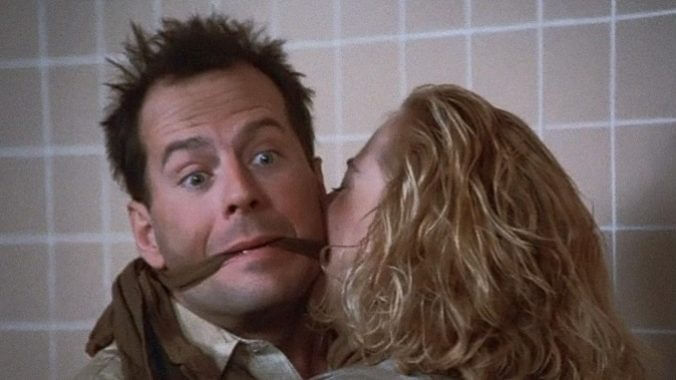As Moonlighting Arrives on Hulu, Here’s Why It Remains Such a Watchable Hot Mess

“Some fly by night….”
If you were an 1980s kid who read their TV Guides cover-to-cover and got excited about ABC promo images for the next episode of Moonlighting, that opening phrase from Al Jarreau’s silky theme song for the ABC dramedy works like a time machine trigger for your brain. That sax line instantly takes me back to the heyday of the Blue Moon Detective Agency, where former model Maddie Hayes (Cybill Shepherd) and wisecracking David Addison (Bruce Willis) solved mysteries, sizzled with sexual tension, and invented meta TV before it got cool two decades later.
Thirty-eight years after it debuted on March 3, 1985, Glenn Gordon Caron’s hit series Moonlighting finally makes its debut on streaming October 10 on Hulu. Having only produced 67 episodes over five production-plagued seasons, Moonlighting never got a “second life” in syndication and only had a limited DVD release in the mid 2000s, which means it’s been out of the modern zeitgeist, pretty much a blind spot show for millennials and Gen Z.
One can already imagine the younger generation’s reception to some of the show’s very 1980s TV detective series banter, and particularly Addison’s relentlessly horny verbal pursuit of Maddie. But there’s also a lot to still appreciate about Moonlighting and how innovative—sometimes out of sheer necessity—the series was in destroying norms for traditional television rom-coms, reliable mysteries and dramas.
A Little History
Before Moonlighting, Caron played with the simmering mystery partner genre with the TV series Remington Steele. Stephanie Zimbalist was Laura Holt, a private eye who can’t get clients because she’s a woman. So, she invents a boss named Remington Steele, only to have a suave guy claiming to be that man (Pierce Brosnan) walk into her office and become her partner.
Caron clearly honed his casting for chemistry and witty dialogue skills on Steele, which he then amped up by a million for Moonlighting. Wanting to do another romantic mystery series, Caron inadvertently created one in the heightening style of Howard Hawk’s His Girl Friday, with Maddie and Addison having very similar vibes to Cary Grant’s Walter Burns and Rosalind Russell’s Hildy Johnson. The pilot debuted as a TV movie that set up how Maddie’s life implosion leads to her Addison and establishes their prickly yet witty partnership as investigators in Los Angeles.
Caron wrote Maddie with Shepherd in mind, as she too was a former model-turned-actress constantly being underestimated or pigeon-holed for her looks. However, David Addison was a different story, with 2,000 auditions dredging up a then-unknown Willis to the top of Caron’s list. ABC didn’t like him and didn’t buy their chemistry, so Caron had to fight to even get him a provisional pass to make the pilot.
As the lore goes, Willis’ debut in Moonlighting earned one of those lighting-in-a-bottle audience reactions of: “Who is that?” Critics and viewers loved his smirk and lighting fast quips, plus his palpable chemistry with Shepherd’s very forthright and independent Maddie. Watching the series today, as much as Addison is guilty of firing out era-common, cringey casual misogyny, Maddie absolutely never lets him get away with it. She’s got plenty of fire in her belly despite her profession making her world-weary and is uninterested in suffering (especially) male fools. As such, she either calls Addison out immediately, or catalogs his sexism for a more pointed inventory of his failings which is remarkably contemporary.
Ahead of Its Time
There are plenty of shows that get continually name-checked for having an inordinate impact on the TV medium, from Twin Peaks to Seinfeld to Lost. Not only did they redefine what could be done in their genres, they also had a huge influence on writers who watched them and then went on to make their own impactful TV shows. Moonlighting also belongs in that list of game changers because Caron and his writers embraced redefining what a drama with comedy (a dramedy) might do in terms of pushing rules and structure.
-

-

-

-

-

-

-

-

-

-

-

-

-

-

-

-

-

-

-

-

-

-

-

-

-

-

-

-

-

-

-

-

-

-

-

-

-

-

-

-








































